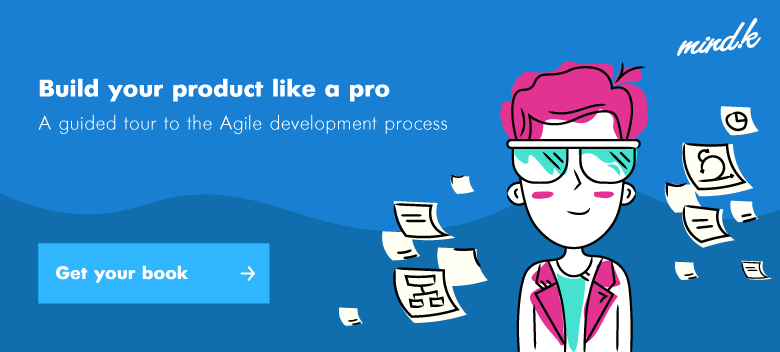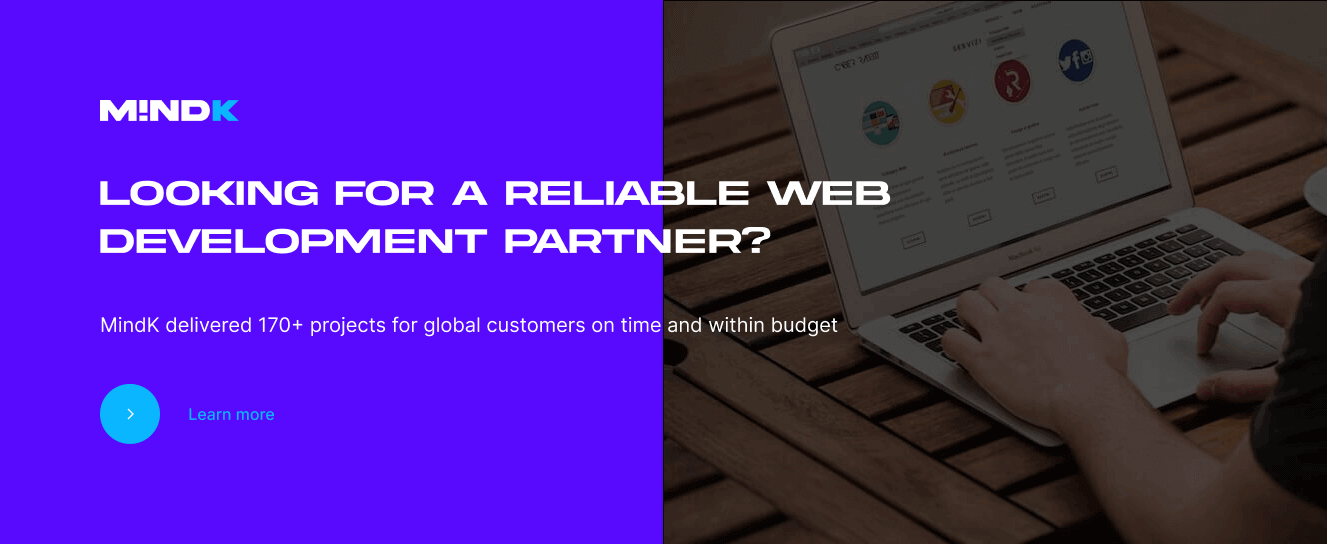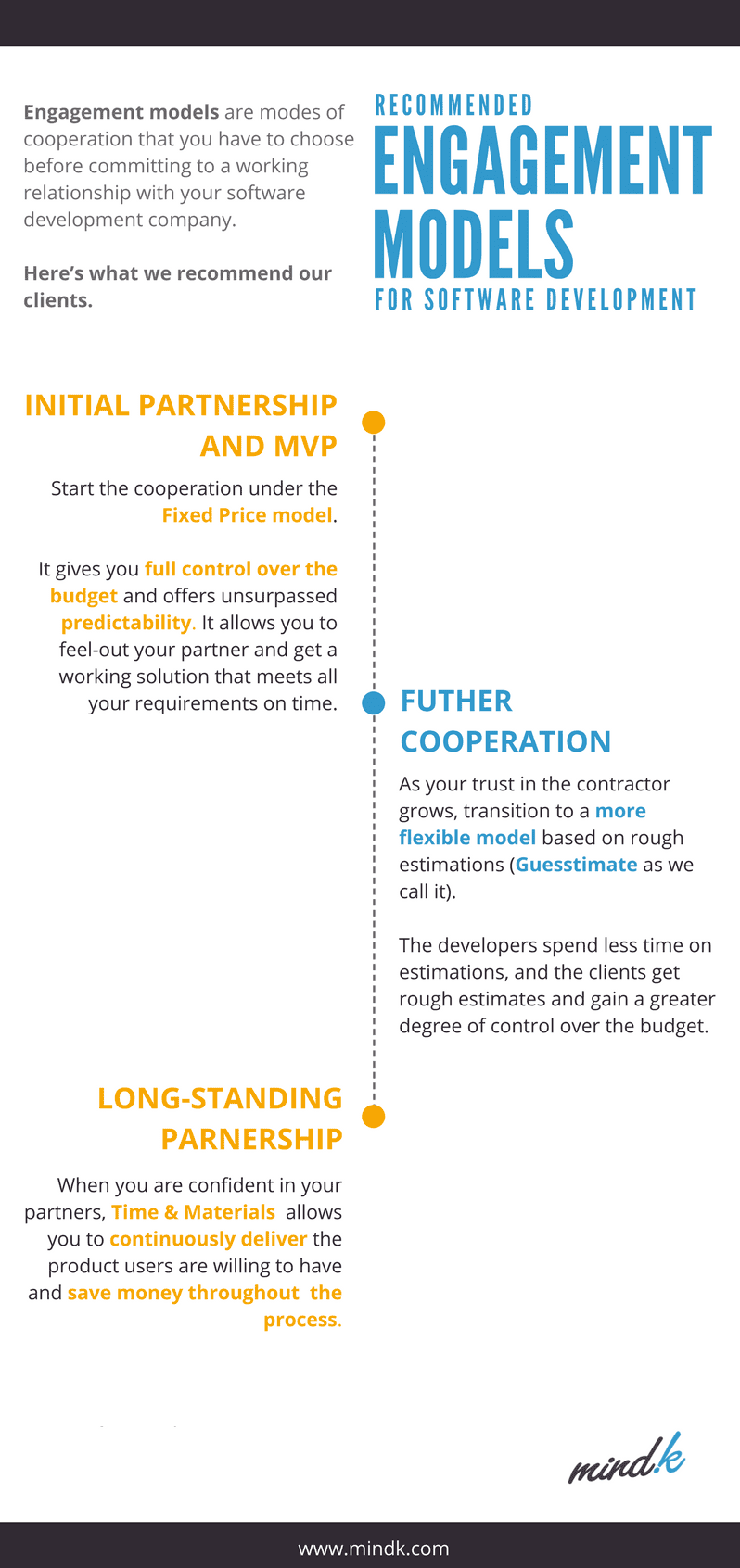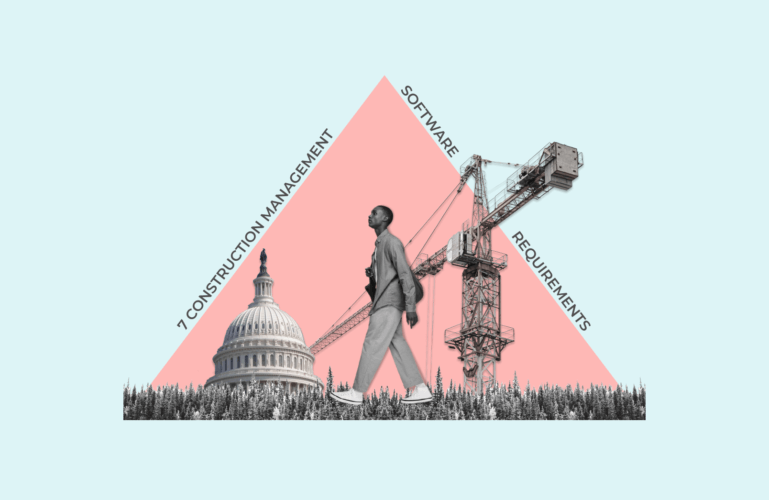Engagement models are different modes of cooperation that you have to choose before committing to a healthy working relationship. Today I’ll draw the curtain and help you find the one that works best for your business.
As a web and mobile app development company we time and again stress the importance of transparency in software development. Over the years we’ve formed our work standards, including engagement models, to ensure smooth collaboration between us and our clients.
All the various models fall into either of the two categories: Fixed Price or Non-fixed Price models. Fixed Price contracts are characterized by the specific requirements and a price tag that is not subject to change. Non-fixed Price models offer a degree of flexibility that is ideal for the rapidly changing realities.
So, let’s take a deeper look at what they represent and outline all the possible pros and cons for you.
Fixed Price Engagement Model
This option that is sometimes called fixed bid or lump sum contract, is the most obvious of the bunch. From its name alone you can see that this model is all about freezing the costs of your project in place long before the development starts.
It’s also about meticulously documenting all the requirements, drawing out a detailed scope of the project, and setting up a strict timetable with well-defined milestones. But most of all it is about predictability.
A rigorous definition of requirements, project scope, and your end-goal is a must for the fixed price model.
Before the development starts, MindK business analysis crew organizes a series of extensive interviews with the client in order to find out every little detail regarding the future project. Together we determine the use cases, write user stories, and construct wireframes in order to help with the visualization of user experience and interface.
The result of this stage is a detailed technical specification, estimation, development schedule and prototype.
From this point onwards, all of these are set in stone and not subject to change during the development process.
There is a subtype of this model called Fixed Price Incentive Fee that specifically sets up a system of bonuses and maluses based on adhering to the schedule.
The benefits of the Fixed Price model:
- Predictability and transparency: you’ll get the precise budget and deadlines before the development starts.
- Compared to other models, fixed price requires less management and supervision on the part of the client, as the development team has specification and know the scope of work and budget beforehand.
- Precise end-goal: from the very beginning you’ll have a good idea on what the final product will look like and expect it to be delivered precisely that way.
- Ideal for establishing trust with a new partner.
The model’s drawbacks:
- Comparatively high cost. As the development company usually shoulders the risk management in its entirety, all risks are calculated in advance and included in the bill. That’s why fixed-price are considered the most expensive of the engagement models. The costs of a man-hour under this model can be up to 1,5 – 2 times more than other types of contracts.
- The requirements gathering and analysis take a lot of time. It could last from a couple of weeks for smaller projects and up to several months for massive undertakings. This may seem like an excessive time and monetary investment, but without a clear definition of requirements, the fixed price model doesn’t work at all.
- Little flexibility, especially when it comes to adding new or altering existing features. Any shortcomings during the initial phase may reflect negatively on latter stages and the result of the final product. If you overlook some tiny feature at the project’s inception or decide sometime later that this functionality should be expanded, you’ll have to renegotiate the whole deal. Thus, development can quickly spiral into a wrestling match between you and a team bound by a strict timetable and budget constraints.
When to choose the model:
- When the requirements are well-defined and unlikely to change during the development.
- For short-to-medium term projects that last up to several months.
- Works best when coupled with the Waterfall software development methodology in which the stages of development happen consecutively. It can also be modified to work with Agile. For this purpose, the contractors may break the whole project into smaller chunks and adjust their billing approach to be based on the achieved milestones.
- At the initial stage of cooperation/while developing a Minimum Viable Product (MVP).
Takeaway: due to the lack of flexibility I’d advise you against this engagement model except for developing an MVP and switching to a more flexible model later on.
Non-fixed Price: Time and Materials
In practice, time and material contracts (aka T&M) allow much greater flexibility than fixed price alternatives. When vision of the product is not crystal-clear, when the reality of the market changes dynamically, when the involved tech rapidly evolves, you can’t predict the full and final project scope.
In such cases, you can either divide them into smaller more manageable bits and proceed with the Fixed Price model, or you can start the development without precise requirements using the T&M and pay as you go.
This means that the T&M model requires greater involvement on the part of the client but at the same time, gives them greater control over the project. Depending on emerging requirements and current priorities, the size and composition of the team can also be adjusted on the fly.
The benefits of the Time & Material:
- Extremely flexible when it comes to project budget and scope; pretty good at handling requests for additions or changes.
- Full use of the Agile software development methodology to efficiently drive durable projects. To this end, the project is divided into smaller tasks and the client prioritize them according to current business needs.
- A much greater degree of control over the project for the client.
- Low risk to both clients and developers.
- Quicker development start by speeding up the requirements gathering stage.
- Cheaper for the clients because the developer doesn’t have to overcharge the customer for risks.
The model’s drawbacks:
- More oversight needed on part of the client.
- No rock-solid guarantees that the project will be completed on time.
- Discrepancy between the projected estimate and real costs of the project.
When to choose the model:
- If the requirements are not precise enough or when it’s not feasible to dedicate significant time and resources to define them.
- If there is a great probability that the requirements will change during the development process.
- For larger projects that take from several months to a few years.
- For later iterations of an MVP completed under a fixed price model.
- When the project aimed at the rapidly shifting markets or uses some cutting-edge tech.
Takeaway: Time and Materials engagement model suits the long-term cooperation between the client with evolving requirements, and trusted development companies. T&M complements the Agile methodology.
Non-fixed Price: Cost Plus
The Cost Plus model is mostly used for outstaffing or personnel leasing, a practice when one company lends some of its specialists to another company for a specified period.
In practice this means that you as a client can “borrow” a couple of developers/QA engineers, etc. that work for you until they complete the project or their services are no longer required.
The client pays the developers’ wages plus all expenses incurred in the process plus a contractor’s fee. At the end of each month, the contractor sends a comprehensive breakdown of all the evidence-backed expenses relating to the project.
They range from the developers’ wages to electricity bills and management expenses. This exceptional price transparency is the defining characteristic of the model and has earned it the title of Open Book Model.
Depending on the way the profit margin is calculated, the model is divided into three subtypes:
- Cost Plus Fixed Fee. The contractor’s fee is set in stone like with a Fixed Price contract.
- Cost Plus % Fee. The contractor’s fee is proportional to the total expenses incurred on the project. My advice is to avoid this model as it can incentivize the contractor to spend as much as possible in order to increase the profits.
- Cost Plus Incentive Fee. The contractor’s profit is calculated based on the target cost to actual cost ratio; i.e the developer gets more for spending less/working faster.
The benefits of the Cost Plus model as well as its drawbacks are pretty similar to that of Time & Material. It’s usually cheaper, faster, and less risky than the Fixed Price bid but requires more oversight on part of the clients. Its additional benefit is the superb cost transparency.
Its unique disadvantage is that oftentimes, developers specify in their Cost Plus contracts that the clients must warn them 2-3 months in advance of their service cancellation.
Non-fixed Price: Dedicated Team/Dedicated Development Center (DDC)
Development companies offer the DDC model to clients who need to augment their existing team with a few remote specialists or create a fully-fledged offshore development center. In this case, the contractor takes on the role of both an outsourcing provider and an HR agency of sorts.
The development company provides the specialists that have the required expertise and the client hand-picks them for the team. The contractor guarantees the high professionalism and strong work ethics of each team member.
The dedicated team integrates seamlessly with your existing structures, adopts your corporate culture, methodologies, best practices, and tech. The longer the cooperation lasts, the more integrated becomes the team and the more invested become its members in the success of the project.
The model is perfect for long-term cooperation on complex and extensive projects. It retains a lot of flexibility and works well with either Agile or Waterfall methodologies.
The benefits of Dedicated Development Center:
- Exceptional amount of control over all aspects of development.
- Tight security and IP protection.
- Predictable budget despite the varying workload and dynamic scope.
- Great flexibility when compared to the fixed price model, compatibility with Agile methodology.
- Strong understanding of the client’s needs on part of the team as a consequence of close cooperation and long-term partnership.
The model’s drawbacks:
- Cost-ineffective for small projects.
- Requires the client to have a significant involvement in the project, take active part in communication and management (unless the contractor provides the management). The contractor retains the responsibility for smooth communications.
- Costlier than T&M model in cases with variable workload.
- Hand-picking the team members can take quite a bit of time and delay the start of development.
When to choose the model:
- You want to staff up your existing team.
- You have enough expertise and capacity to manage the product development but lack the “muscle” to deliver and support the product.
- You look for long-term cooperation and require maximum control over the project.
- You want to create an offshore IT department to develop/support your products.
Takeaway: choose DDC when you are ready for a long-standing partnership and need a stable team to develop and support your product. Alternatively, use the model to boost your existing workforce.
Conclusion
As an afterword of sorts, I’d like to reiterate the importance of care and transparency in outsourcing relationships.
Every time you initiate a partnership with a software development company you enter untested waters. It’s OK to feel a little bit uneasy at this point. That’s why we recommend our clients start the cooperation under the Fixed Price model.
It gives you full control over the budget and offers unsurpassed predictability. It allows you to feel-out your partner and get a working solution that meets all your requirements on time.
As your trust in the contractor grows, you can transition to a more flexible model based on rough estimations (Guesstimate as we call it). Using this model, we produce approximate estimates that don’t require that much time investment when compared to the Fixed Price model.
If some feature requires more man-hours to implement than initially estimated, we decide together with the clients if it’s better to allocate more time to the feature or limit the project’s scope instead.
This model is convenient both for the developers who spend less time on estimations, and for the clients who get rough estimates and gain a greater degree of control over the budget.
We recommend our clients the Time and Materials model for further cooperation.
When you are confident in your partners, when the results of your cooperation speak for themselves, T&M allows you to continuously deliver the product users are willing to have and save money throughout the process.
I hope this guide will help you make the right choice when it comes to engagement models. You are welcome to save our cheatsheet, it will help you stay on the right track.









